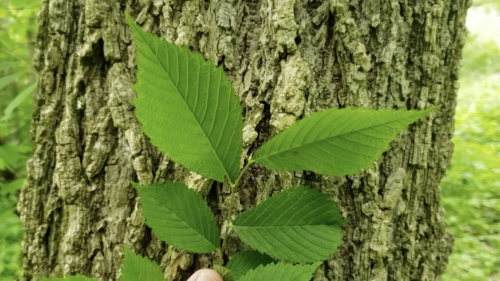 Purdue University - Extension - Forestry and Natural Resources
Purdue University - Extension - Forestry and Natural Resources
Got Nature? Blog
 American elms have been the victim of a decimating disease known as DED or Dutch Elm Disease. However, there are a few that linger and remain, gracing our city streets with their majestic arching form. Many elms are mistakenly identified as American; however, there are many other “weedy” elms that have naturally inhabited our urban landscape. Due to the incredible interest in these trees, plant breeders have developed resistant American elms which are showing excellent results. Unfortunately, many of those trees proved to be susceptible to other diseases such as Elm Yellows.
American elms have been the victim of a decimating disease known as DED or Dutch Elm Disease. However, there are a few that linger and remain, gracing our city streets with their majestic arching form. Many elms are mistakenly identified as American; however, there are many other “weedy” elms that have naturally inhabited our urban landscape. Due to the incredible interest in these trees, plant breeders have developed resistant American elms which are showing excellent results. Unfortunately, many of those trees proved to be susceptible to other diseases such as Elm Yellows.
Providing that the tree has been identified as an American elm, proper management is required to maintain its health and vigor to provide a sustainable tree in the landscape.
Strategies include:
Sanitation: Quick removal of diseased trees and symptomatic branches is necessary in managing this disease. Removal of the damaged parts reduces breeding sites for the elm bark beetle and removes the fungus from the vicinity. Branches with “flagging” symptoms should be removed, making a cut well behind (5-8 ft.) any visual symptoms.
Pesticide Applications:
Insecticides to kill bark beetle vectors – Attempt to control the insect vector population by applying an insecticide. Timing of the application may depend on the type of insecticide you have selected. Some insecticides may target the spring feeding sites while others target the overwintering sites and should be applied during late autumn. Use of this management option should be considered carefully. It is difficult to attempt control over this beetle population due to the timing factor, the complete coverage issue, expense and pesticide exposure.
Preventative fungicide injections – There are effective fungicides capable of protecting elm trees from infection, but this method of management should be considered carefully. Fungicide injection must be performed by someone trained in the technique and may be expensive. Protection lasts 1-3 years and then must be repeated. In addition, some researchers are concerned that repeated wounding of the tree (by drilling holes) for the injection may open trees to decay. If there is concern for infestation, it is critical to contact a reputable tree care company specializing in good plant healthcare. Always contact an International Society of Arboriculture Certified Arborist to help insure best practices. For more information on DED and management strategies, click on the links below.
Resources
Dutch Elm Disease
Diseases in Hardwood Tree Plantings
Pest Tracker: Dutch Elm Disease
Lindsey Purcell, Urban Forestry Specialist
Department of Forestry and Natural Resources, Purdue University

Recent Posts
- Report Spotted Lanternfly – Purdue Landscape Report
Posted: April 10, 2024 in Alert, Forestry, Invasive Insects, Plants, Wildlife, Woodlands - Declining Pines of the White Variety – Purdue Landscape Report
Posted: in Alert, Disease, Forestry, Plants, Wildlife, Woodlands - Are you seeing nests of our state endangered swan? – Wild Bulletin
Posted: April 9, 2024 in Alert, Forestry, How To, Wildlife - Cicadas in Spring! – Purdue Landscape Report
Posted: in Forestry, Plants, Safety, Wildlife - New Deer Impact Toolbox
Posted: April 7, 2024 in Forestry, Land Use, Plants, Publication, Safety, Wildlife, Woodlands - 2024-25 Fishing Guide now available – Wild Bulletin
Posted: April 4, 2024 in Alert, Aquaculture/Fish, Aquatic/Aquaculture Resources, How To, Ponds, Wildlife - Help Research Chronic Wasting Disease – Wild Bulletin
Posted: April 3, 2024 in Disease, Forestry, How To, Safety, Wildlife, Woodlands - Indiana Reptiles and Amphibians – IFWOA Webinar
Posted: April 1, 2024 in Forestry, How To, Webinar, Wildlife, Woodlands - Birding through the Seasons – IFWOA Webinar
Posted: in Forestry, How To, Webinar, Wildlife, Woodlands - Look Out for Invasive Carp in Your Bait Bucket – Wild Bulletin
Posted: March 31, 2024 in Alert, Aquaculture/Fish, Aquatic/Aquaculture Resources, Invasive Animal Species, Wildlife
Archives
Categories
- Alert
- Aquaculture/Fish
- Aquatic/Aquaculture Resources
- Ask the Expert
- Christmas Trees
- Community Development
- Disease
- Drought
- Forestry
- Forests and Street Trees
- Gardening
- Got Nature for Kids
- Great Lakes
- How To
- Invasive Animal Species
- Invasive Insects
- Invasive Plant Species
- Land Use
- Natural Resource Planning
- Nature of Teaching
- Plants
- Podcasts
- Ponds
- Publication
- Safety
- Timber Marketing
- Uncategorized
- Urban Forestry
- Webinar
- Wildlife
- Wood Products/Manufacturing
- Woodland Management Moment
- Woodlands